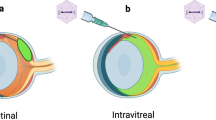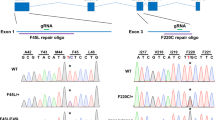Abstract
Patients with retinitis pigmentosa (RP) typically develop night blindness early in life due to loss of rod photoreceptors. The remaining cone photoreceptors are the mainstay of their vision; however, over years or decades, these cones slowly degenerate, leading to blindness. We created transgenic pigs that express a mutated rhodopsin gene (Pro347Leu). Like RP patients with the same mutation, these pigs have early and severe rod loss; initially their cones are relatively spared, but these surviving cones slowly degenerate. By age 20 months, there is only a single layer of morphologically abnormal cones and the cone electroretinogram is markedly reduced. Given the strong similarities in phenotype to that of RP patients, these transgenic pigs will provide a large animal model for study of the protracted phase of cone degeneration found in RP and for preclinical treatment trials.
This is a preview of subscription content, access via your institution
Access options
Subscribe to this journal
Receive 12 print issues and online access
$209.00 per year
only $17.42 per issue
Buy this article
- Purchase on Springer Link
- Instant access to full article PDF
Prices may be subject to local taxes which are calculated during checkout
Similar content being viewed by others
References
Dryja, T.P. and Berson, E.L. 1995. Retinitis pigmentosa and allied diseases: Implications of genetic heterogeneity. Invest Ophthalmol. Vis. Sci. 36: 1197–1200.
Gal, A., Apfelstedt-Sylla, E., Janecke, A.R. and Zrenner, E. 1997. Rhodopsin mutations in inherited retinal dystrophies and dysfunctions. Progress in Retinal and Eye Research 16: 51–79.
Massof, R.W. and Finkelstein, D. 1987. A two-stage hypothesis for the natural course of retinitis pigmentosa, pp. 29–58 in Advances in the biosciences, Vol. 62. Zrenner, E., Krastel, H., and Goebel, H.-H. (eds.) Pergamon Journals Ltd, Elmsford, NY.
Travis, G.H. 1997. Insights from a lost visual pigment. Nature Genetics 15: 115–117.
Steinberg, R.H., Flannery, J.G., Naash, M., Oh, P., Matthes, M.T., Yasumura, D. et al. 1996. Transgenic rat models of inherited retinal degeneration caused by mutant opsin genes. Invest. Ophthalmol. Vis. Sci. 37: S698.
Humphries, M.M., Rancourt, D., Farrar, G.J., Kenna, P., Hazel, M., Bush, R.A. et al. 1997. Retinopathy induced in mice by targeted disruption of the rhodopsin gene. Nature Genetics 15: 216–219.
Acland, G.M., Fletcher, R.T., Gentleman, S., Chader, G.J. and Aguirre, G.D. 1989. Non-allelism of three genes (rcd1, rcd2 and erd) for early-onset hereditary retinal degeneration. Exp. Eye Res. 49: 983–998.
Suber, M.L., Pittler, S.J., Qin, N., Wright, G.C., Holcombe, V., Lee, R.H. et al. 1993. Irish setter dogs affected with rod/cone dysplasia contain a nonsense mutation in the rod cGMP phosphodiesterase beta-subunit gene. Proc. Natl. Acad. Sci. USA 90: 3968–3972.
Narfstrom, K. 1983. Hereditary progressive retinal atrophy in the Abyssinian cat. J. Hered. 74: 273–276.
Semple-Rowland, S.L., Gorczyca, W.A., Buczylko, J., Helekar, B.S., Ruiz, C.C., Subbaraya, I. et al. 1996. Expression of GCAP1 and GCAP2 in the retinal degeneration (rd) chicken retina. FEBS Lett. 385: 47–52.
Chang, G.-Q., Hao, Y. and Wong, F. 1993. Final common pathway of photoreceptor death in rd, rds, and rhodopsin mutant mice. Neuron 11: 595–605.
Portera-Cailliau, C., Sung, C.-H., Nathans, J. and Adler, R. 1994. Apoptotic photoreceptor cell death in mouse models of retinitis pigmentosa. Proc. Natl. Acad. Sci. USA 91: 974–978.
Lolley, R.N., Rong, H. and Craft, C.M. 1994. Linkage of photoreceptor degeneration by apoptosis with inherited defect in phototransduction. Invest. Ophthalmol. Vis. Sci. 35: 358–362.
Chen, J., Flannery, J.G., LaVail, M.M., Steinberg, R.H., Xu, J. and Simon, M.I. 1996. bcl-2 overexpression reduces apoptotic photoreceptor cell death in three different retinal degenerations. Proc. Natl. Acad. Sci. USA 93: 7042–7047.
Hafezi, F., Steinbach, J.P., Marti, A., Munz, K., Wang, Z.Q., Wagner, E.F. et al. 1997. The absence of c-fos prevents light-induced apoptotic cell death of photoreceptors in retinal degeneration in vivo. Nature Medicine 3: 346–349.
Aebischer, P., Schluep, M., Deglon, N., Joseph, J.-M., Hirt, L., Heyd, B. et al. 1996. Intrathecal delivery of CNTF using encapsulated genetically modified xenogeneic cells in amyotrophic lateral sclerosis patients. Nature Medicine 2: 696–699.
Prince, J.H., Diesem, C.D., Eglitis, I. and Ruskell, G.L. 1960. The pig, pp. 210–233 in Anatomy and histology of the eye and orbit in domestic animals. Charles C. Thomas, Springfield, IL.
Gerke, C.G. Jr, Hao, Y. and Wong, F. 1995. Topography of rods and cones in the retina of the domestic pig. Hong Kong Medical Journal 1: 302–308.
Hammer, R.E., Pursel, V.G., Rexroad, C.E. Jr, Wall, R.J., Bolt, D.J., Ebert, K.M. et al. 1985. Production of transgenic rabbits, sheep and pigs by microinjection. Nature 315: 680–683.
Pursel, V.G., Pinkert, C.A., Miller, K.F., Bolt, D.J., Campbell, R.G., Palmiter, R.D. et al. 1989. Genetic engineering of livestock. Science 244: 1281–1288.
Sharma, A., Martin, M.J., Okabe, J.F., Truglio, R.A., Dhanjal, N.K., Logan, J.S. and Kumar, R. 1994. An isologous porcine promoter permits high level expression of human hemoglobin in transgenic swine. Bio/Technology 12: 55–59.
Fodor, W.L., Williams, B.L., Matis, L.A., Madri, J.A., Rollins, S.A., Knight, J.W. et al. 1994. Expression of a functional human complement inhibitor in a transgenic pig as a model for the prevention of xenogeneic hyperacute organ rejection. Proc. Natl. Acad. Sci. USA 91: 11153–11157.
Dryja, T.P., McGee, T.L., Hahn, L.B., Cowley, G.S., Olsson, J.E., Reichel, E. et al. 1990. Mutations within the rhodopsin gene in patients with autosomal dominant retinitis pigmentosa. N. Engl. J. Med. 323: 1302–1307.
Berson, E.L., Rosner, B., Sandberg, M.A., Weigel-DiFranco, C. and Dryja, T.P. 1991. Ocular findings in patients with autosomal dominant retinitis pigmentosa and rhodopsin, proline-347-leucine. Am. J. Ophthalmol. 111: 614–623.
Shiono, T., Hotta, Y., Noro, M., Sakuma, T., Tamai, M., Hayakawa, M. et al. 1992. Clinical features of Japanese family with autosomal dominant retinitis pigmentosa caused by point mutation in codon 347 of rhodopsin gene. Jpn. J. Ophthalmol. 36: 69–75.
Fujiki, K., Hotta, Y., Hayakawa, M., Sakuma, H., Shiono, T., Noro, M. et al. 1992. Point mutations of rhodopsin gene found among Japanese families with autosomal dominant retinitis pigmentosa (ADRP). Jpn. J. Hum. Genet. 37: 125–132.
Apfelstedt-Sylla, E., Kunisch, M., Horn, M., Ruether, K., Gal, A., Zrenner, E. 1992. Diffuse loss of rod function in autosomal dominant retinitis pigmentosa with pro-347-leu mutation of rhodopsin. Ger. J. Ophthalmol. 1: 319–327.
Wall, R.J., Pursel, V.G., Hammer, R.E. and Brinster, R.L. 1985. Development of porcine ova that were centrifuged to permit visualization of pronuclei and nuclei. Biol. Reprod. 32: 645–651.
Nathans, J., 1992. Structure, function, and genetics. Biochemistry 31: 4923–4931.
Feeney-Burns, L., Malinow, M.R., Klein, M.L. and Neuringer, M. 1981. Maculopathy in cynomolgus monkeys. Arch. Ophthalmol. 99: 664–672.
Tso, M.O.M. 1989. Experiments on visual cells by nature and man: In search of treatment for photoreceptor degeneration. Invest. Ophthalmol. Vis. Sci. 30: 2430–2454.
Hood, D.C. and Birch, D.G. 1994. Rod phototransduction in retinitis pigmentosa: estimation and interpretation of parameters derived from the rod a-wave. Invest. Ophthalmol. Vis. Sci. 35: 2948–2961.
Reiser, M.A., Williams, T.P. and Pugh, E.N., 1996. The effect of light history on the aspartate-isolated fast-Pill responses of the albino rat retina. Invest. Ophthalmol. Vis. Sci. 37: 221–229.
Olsson, J.E., Gordon, J.W., Pawlyk, B.S., Roof, D., Hayes, A., Molday, R.S. et al. 1992. Transgenic mice with a rhodopsin mutation (Pro23His): a mouse model for autosomal dominant retinitis pigmentosa. Neuron 9: 815–830.
Sung, C.H., Makino, C., Baylor, D. and Nathans, J. 1994. A rhodopsin gene responsible for autosomal dominant retinitis pigmentosa results in a protein that is defective in localization to the photoreceptor outer segment. J. Neurosci. 14: 5818–5833.
Li, T., Snyder, W.K., Olsson, J.E. and Dryja, T.P. 1996. Transgenic mice carrying the dominant rhodopsin mutation P347S: Evidence for defective vectorial transport of rhodopsin to the outer segments. Proc. Natl. Acad. Sci. USA 93: 14176–14181.
Huang, P.C., Gaitan, A.E., Hao, Y., Petters, R.M. and Wong, F. 1993. Cellular interactions implicated in the mechanism of photoreceptor degeneration in transgenic mice expressing a mutant rhodopsin gene. Proc. Natl. Acad. Sci. USA 90: 8484–8488.
Roof, D.J., Adamian, M. and Hayes, A. 1994. Rhodopsin accumulation at abnormal sites in retinas of mice with a human P23H rhodopsin transgene. Invest. Ophthalmol. Vis. Sci. 35: 4049–4062.
Wong, F. 1997. Investigating retinitis pigmentosa: a laboratory scientist's perspective. Progress in Retinal and Eye Research 16: 353–373.
Sambrook, J., Fritsch, E.F. and Maniatis, T. 1989. Molecular cloning, 2nd ed. Cold Spring Harbor Laboratory Press, Cold Spring Harbor, NY.
Kunkel, T.A., Roberts, J.D. and Zakour, R.A. 1987. Rapid and efficient site-specific mutagenesis without phenotypic selection. Methods Enzymol. 154: 367–382.
Jacobson, S.G., Kemp, C.M., Borruat, F.-X., Chaitin, M.H. and Faulkner, D.J. 1987. Rhodopsin topography and rod-mediated function in cats with the retinal degeneration of taurine deficiency. Exp. Eye Res. 45: 481–490.
Kemp, C.M., Jacobson, S.G., Borruat, F.-X. and Chaitin, M.H. 1989. Rhodopsin levels and retinal function in cats during recovery from vitamin A deficiency. Exp. Eye Res. 49: 49–65.
Cideciyan, A.V. and Jacobson, S.G. 1996. An alternative phototransduction model for human rod and cone ERG a-waves: normal parameters and variation with age. Vision Res. 36: 2609–2621.
Hood, D.C. and Birch, D.G. 1990. A quantitative measure of the electrical activity of human rod photoreceptors using electroretinograms. Visual Neuroscience 5: 379–387.
Lamb, T.D. and Pugh, E.N., 1992. A quantitative account of the activation steps involved in phototransduction in amphibian photoreceptors. J. Physiol. 449: 719–758.
Jacobson, S.G., Kemp, C.M., Cideciyan, A.V., Macke, J.P., Sung, C.-H., and Nathans, J. 1994. Phenotypes of stop codon and splice site rhodopsin mutations causing retinitis pigmentosa. Invest. Ophthalmol. Vis. Sci. 35: 2521–2534.
Jacobson, S.G., Voigt, W.J., Parel, J.-M., Nghiem-Phu, L., Myers, S.W., and Patella, V.M. 1986. Automated light- and dark-adapted perimetry for evaluating retinitis pigmentosa. Ophthalmology 93: 1604–1611.
Jacobson, S.G., Kemp, C.M., Sung, C.-H. and Nathans, J. 1991. Retinal function and rhodopsin levels in autosomal dominant retinitis pigmentosa with rhodopsin mutations. Amer. J. Ophthalmol. 112: 256–271.
Author information
Authors and Affiliations
Corresponding author
Rights and permissions
About this article
Cite this article
Petters, R., Alexander, C., Wells, K. et al. Genetically engineered large animal model for studying cone photoreceptor survival and degeneration in retinitis pigmentosa. Nat Biotechnol 15, 965–970 (1997). https://doi.org/10.1038/nbt1097-965
Received:
Accepted:
Issue Date:
DOI: https://doi.org/10.1038/nbt1097-965
This article is cited by
-
The p-ERG spatial acuity in the biomedical pig under physiological conditions
Scientific Reports (2022)
-
A rat model for retinitis pigmentosa with rapid retinal degeneration enables drug evaluation in vivo
Biological Procedures Online (2021)
-
ROCK inhibition reduces morphological and functional damage to rod synapses after retinal injury
Scientific Reports (2021)
-
Swine models, genomic tools and services to enhance our understanding of human health and diseases
Lab Animal (2017)
-
Dampening Spontaneous Activity Improves the Light Sensitivity and Spatial Acuity of Optogenetic Retinal Prosthetic Responses
Scientific Reports (2016)



